Introduction: An Artist Between Worlds
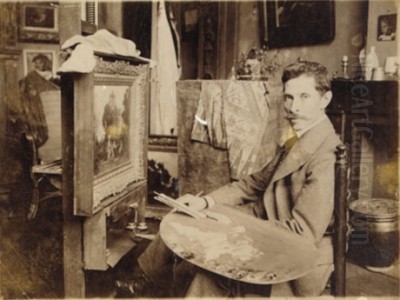
Johannes Evert Hendrik Akkeringa stands as a significant figure in Dutch art history, particularly associated with the later phase of the renowned Hague School. Born on June 17, 1861, in Buitenzorg (now Bogor) in the Dutch East Indies (present-day Indonesia), his life began far from the grey skies and coastal light he would later capture so masterfully. Akkeringa's artistic journey led him back to the Netherlands, where he developed a distinctive Impressionistic style, celebrated for its intimate portrayal of domestic life, sun-drenched gardens, and the simple beauty of the Dutch landscape. He passed away in Amersfoort on April 12, 1942, leaving behind a body of work cherished for its tranquility, warmth, and technical finesse.
Akkeringa's art is characterized by a delicate sensitivity to light and atmosphere. He excelled in depicting quiet, everyday moments – children playing on the beach, women engaged in domestic tasks, serene garden corners, and vibrant floral arrangements. While firmly rooted in the principles of the Hague School, his work possesses a personal charm and a focus on the brighter, more optimistic aspects of life, often distinguishing him from some of the more somber tones found in the works of the school's earlier masters. He became a respected member of the Dutch art community, contributing significantly to the continuation and evolution of realist and Impressionist traditions in the Netherlands.
Early Life and Artistic Formation
Born into a Dutch family residing in the colonial setting of the Dutch East Indies, Akkeringa's early environment was vastly different from the Netherlands. His father, Johannes Evert Akkeringa Sr., worked in the colony. Historical accounts suggest the elder Akkeringa faced hardships, potentially succumbing to the tropical climate and diseases like malaria, a common fate for Europeans in the region at the time. This background perhaps instilled in the young artist an appreciation for the different qualities of light and life he would later encounter in Europe.
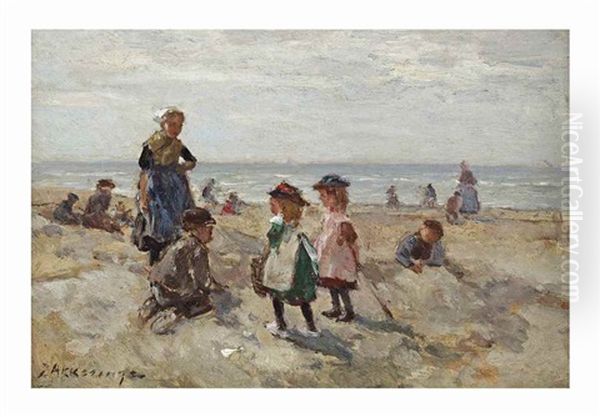
Following his family's return to the Netherlands, Akkeringa settled in The Hague. His artistic talents emerged early, leading him to pursue formal training. He enrolled at the prestigious Royal Academy of Art (Koninklijke Academie van Beeldende Kunsten) in The Hague, a central institution for aspiring artists in the country. Here, he honed his skills in drawing and painting, likely studying under figures associated with the Academy during that period, absorbing the foundational principles of academic art while being exposed to the burgeoning influence of realism and Impressionism that characterized the Hague School. He also reportedly spent some time studying in Rotterdam, further broadening his artistic education.
His training provided him with a solid technical foundation, particularly in draughtsmanship, which underpinned his later, looser painting style. The environment of The Hague, the center of the eponymous school of painting, was crucial. He was immersed in an atmosphere where direct observation of nature, atmospheric effects, and the depiction of local life were highly valued. This context profoundly shaped his artistic direction, guiding him towards the subjects and stylistic approaches that would define his career.
The Hague School Context: Light, Atmosphere, and Dutch Life
To understand Akkeringa's contribution, one must appreciate the Hague School (Haagse School), the dominant movement in Dutch painting during the latter half of the 19th century. Flourishing roughly between 1860 and 1890, with its influence extending into the early 20th century, the school represented a move away from the romanticized landscapes of the earlier 19th century towards a more realistic and atmospheric portrayal of the Dutch environment and its inhabitants.
Inspired partly by the French Barbizon School, Hague School artists sought to capture the unique light and mood of the Dutch landscape – its flat polders, canals, beaches, and fishing villages – often under characteristic grey, silvery skies. Key figures of the first generation included masters like Jozef Israëls, known for his poignant depictions of peasant and fisherfolk life; Willem Roelofs, a pioneer in landscape painting; Anton Mauve, famous for his sheep flocks and rural scenes (and a cousin-in-law and early teacher of Vincent van Gogh); the Maris brothers – Jacob Maris (landscapes and townscapes), Willem Maris (meadows with cattle, emphasizing light on water), and Matthijs Maris (more mystical, dreamy subjects); Hendrik Willem Mesdag, renowned for his seascapes, particularly the Panorama Mesdag; Johannes Bosboom, specializing in church interiors; Paul Gabriël, known for his colourful landscapes; and Johan Hendrik Weissenbruch, a master of watercolour and atmospheric landscapes.
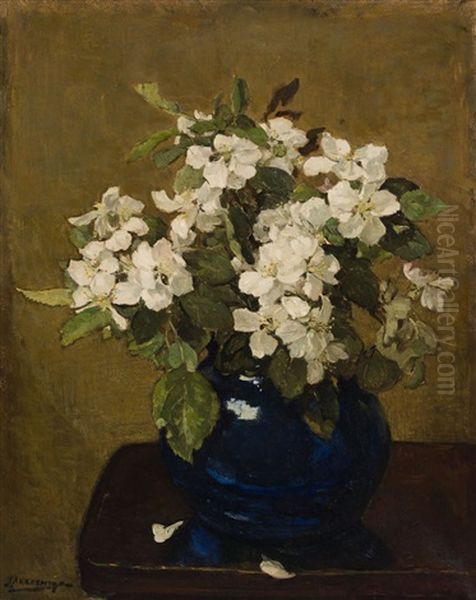
Akkeringa emerged during the later phase or "second generation" of the Hague School, alongside artists such as George Hendrik Breitner and Isaac Israëls (son of Jozef), who would eventually become leading figures of Amsterdam Impressionism, known for their dynamic city scenes. Other contemporaries associated with the Hague School's later period or related styles included Floris Arntzenius, noted for his Hague cityscapes; Willem Bastiaan Tholen, versatile in landscape and cityscape; Suze Robertson, with her powerful, expressive style; Théophile de Bock, a landscape painter influenced by Corot and Jacob Maris; and Bernard Blommers, known for his charming scenes of fisherfolk families.
Akkeringa absorbed the Hague School's emphasis on atmosphere, tonal harmony, and truthful observation. However, his palette often tended to be brighter, and his subjects frequently focused on more intimate, sunnier scenes compared to the often grey and melancholic mood favoured by some of the earlier masters. He carved his own niche within this influential movement.
Akkeringa's Artistic Style: Intimacy, Light, and Colour
Johannes Akkeringa developed a style that, while indebted to the Hague School, possessed its own distinct character. His work is often described as intimate, charming, and imbued with a sense of quiet joy. He was particularly adept at capturing the effects of light, whether it was sunlight filtering through leaves in a garden, illuminating a domestic interior, or sparkling on the sea along the Scheveningen coast.
His brushwork evolved towards an Impressionistic looseness, using visible strokes to suggest form and texture rather than delineating every detail sharply. This technique contributed to the lively, spontaneous feel of many of his paintings. He often employed a relatively bright and varied palette, especially in his floral still lifes and garden scenes, moving beyond the predominantly grey and brown tones associated with the early Hague School. Soft, harmonious colours dominate his canvases, creating a peaceful and inviting atmosphere.
A recurring theme in commentary on Akkeringa's work is its "unstudied" or "snapshot" quality. He seemed to capture moments as if glimpsed casually, preserving their naturalness and lack of pretension. This effect was achieved through careful composition and a focus on everyday subjects, presented without overt sentimentality but with genuine warmth and affection. Whether depicting children absorbed in play or women quietly mending nets, his paintings convey a sense of authenticity and peaceful absorption in the task or moment at hand.
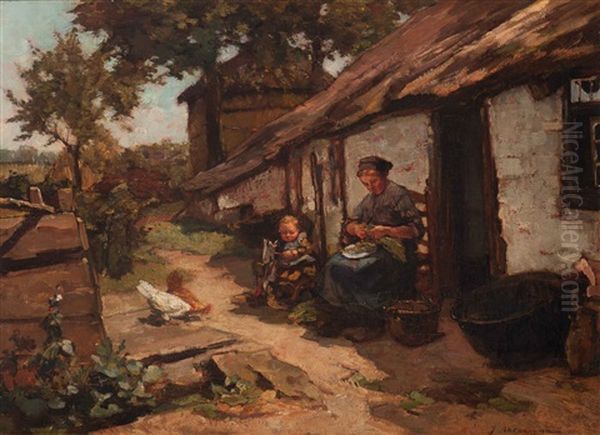
He worked primarily in oils, but like many Hague School artists, was likely proficient in watercolour as well, a medium well-suited to capturing fleeting atmospheric effects. His technique sometimes involved specific methods like "glazing" – applying thin, transparent layers of paint – to achieve particular effects of light and luminosity, as noted in works like Behind the House. This technical skill allowed him to render subtle nuances of light and colour effectively.
Themes and Subjects: The Poetry of the Everyday
Akkeringa's choice of subjects reflects his interest in the beauty of ordinary life and the immediate environment. He repeatedly returned to several key themes throughout his career.
Gardens and Flowers: Gardens, particularly sunlit corners filled with blooming flowers, were a favourite motif. Works like Apple Blossom exemplify his ability to capture the delicate beauty of nature in bloom, using vibrant colours and lively brushwork to convey the freshness and vitality of spring. These scenes often feature figures, typically women or children, enjoying the tranquility of the garden setting, adding a human element to the natural beauty. His floral still lifes are equally celebrated for their freshness and skillful arrangement of colour and form.
Beach Scenes and Children: The nearby Scheveningen beach provided endless inspiration. Akkeringa frequently painted scenes of children playing on the sand, paddling in the shallow water, or interacting with fisherfolk. Children Playing on the Beach is a prime example, capturing the carefree innocence of childhood against the backdrop of the sea and dunes. These works are notable for their bright light, sense of movement, and affectionate observation of children's activities.
Domestic Interiors and Women's Work: Akkeringa also depicted quiet interior scenes, often featuring women engaged in domestic tasks like sewing, mending, or caring for children. Women Mending Fishing Nets (1932) is a later example of this theme, showcasing his continued interest in the traditional lives of coastal communities. These works often emphasize the play of light within the room and convey a sense of peaceful domesticity and focused activity.
Landscapes: While perhaps less known for pure landscapes than some Hague School contemporaries, Akkeringa did paint scenes of the Dutch countryside and coastline. These works typically share the same emphasis on atmosphere and light found in his other subjects, capturing the specific character of the local environment with sensitivity and skill.
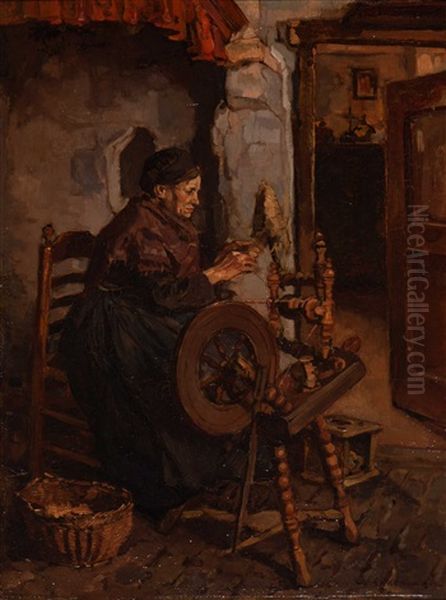
His focus remained consistently on the intimate and the accessible. He avoided grand historical or mythological themes, preferring instead to find poetry and beauty in the familiar world around him. This dedication to the everyday, rendered with technical skill and a gentle, optimistic spirit, defines his contribution to Dutch art.
Analysis of Key Works
Several paintings stand out as representative of Akkeringa's style and thematic concerns.
Children Playing on the Beach: This work encapsulates many of Akkeringa's strengths. It depicts a group of children engrossed in their activities on a sandy beach, likely Scheveningen. The painting is characterized by bright, natural light, suggesting a sunny day. The brushwork is relatively loose and fluid, effectively capturing the movement of the children and the texture of the sand and water. The composition feels natural and unposed, contributing to the "snapshot" quality often attributed to his work. It radiates a sense of warmth, innocence, and the simple pleasures of seaside life. Its exhibition history, including at Museum Flehite, and provenance tracing back to collectors like Mr. J.M. van Bommel, attest to its significance.
Women Mending Fishing Nets (1932): Created later in his career, this painting revisits a theme common to the Hague School – the lives of fisherfolk. It depicts women engaged in the essential task of repairing nets, likely in an interior or sheltered outdoor space. The focus is on the quiet concentration of the women and the textures of the nets and their surroundings. While perhaps more subdued in tone than his beach scenes, it demonstrates Akkeringa's continued commitment to depicting everyday labour with dignity and realism. The fact that it resides in a private collection highlights the appeal of his work beyond public institutions.
Apple Blossom: This painting showcases Akkeringa's talent for capturing the ephemeral beauty of nature. Focusing on apple trees in full bloom, the work is likely characterized by a vibrant palette, with pinks and whites set against the fresh greens of spring foliage. The brushwork would be employed to convey the delicate texture of the blossoms and the play of sunlight through the branches. Such works highlight his connection to Impressionist principles, particularly the interest in capturing fleeting moments and the effects of light on colour in nature.
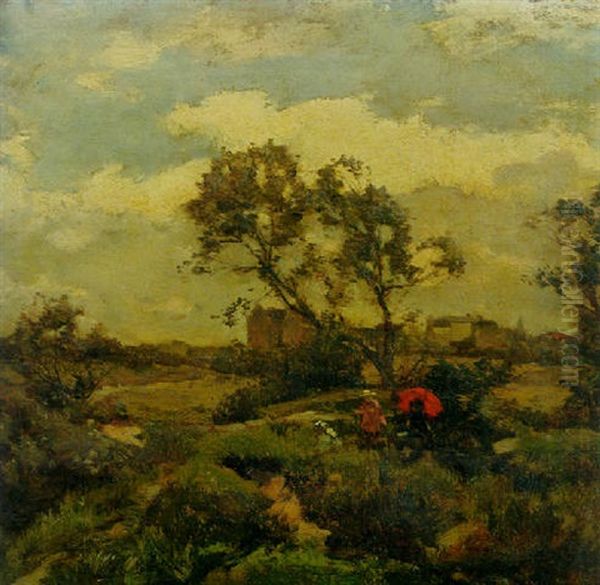
Behind the House: This title suggests a garden or backyard scene, another of Akkeringa's favoured settings. Descriptions mention his use of the "glazing" technique in this work, indicating a careful, layered approach to achieve luminosity and depth. The painting likely depicts a tranquil scene, perhaps featuring figures in a garden, rendered with his characteristic sensitivity to light and atmosphere. The use of glazing suggests a refinement of technique aimed at enhancing the visual richness and subtlety of the scene.
These examples illustrate the core elements of Akkeringa's art: a focus on intimate, everyday subjects, a mastery of light and colour, an accessible Impressionistic technique, and an overall atmosphere of warmth and tranquility.
Relationships with Contemporaries and Artistic Milieu
Akkeringa was an active participant in the art world of The Hague. He was associated with artist societies such as the Pulchri Studio in The Hague and Arti et Amicitiae in Amsterdam, which were vital hubs for exhibitions, discussions, and networking among artists. His membership in these societies placed him firmly within the mainstream of Dutch art at the time.
He maintained connections with fellow artists of the Hague School and related movements. A documented friendship existed with Isaac Israëls, a leading figure who, along with George Hendrik Breitner, spearheaded the movement known as Amsterdam Impressionism. While Israëls and Breitner often focused on the dynamic, bustling life of the city, Akkeringa generally preferred quieter, more pastoral or domestic scenes. Nonetheless, their shared interest in capturing modern life and experimenting with Impressionist techniques suggests a basis for mutual respect and artistic dialogue.
His position is sometimes described as bridging the gap between the earlier Hague School masters and the subsequent generation. While adhering to the core principles of atmospheric realism, his brighter palette and often more cheerful subject matter align him with the evolving tastes of the late 19th and early 20th centuries. He interacted with figures like Floris Arntzenius, who also depicted life in The Hague, albeit often focusing more on street scenes. He would have known the work of landscape specialists like Willem Bastiaan Tholen and the powerful canvases of Suze Robertson.
While direct records of extensive collaboration or intense rivalries might be scarce, Akkeringa operated within a vibrant and interconnected artistic community. He participated in group exhibitions alongside his contemporaries, contributing his unique vision to the broader tapestry of Dutch art during a period of significant stylistic development. His work was generally well-received, finding favour with collectors who appreciated his charming subjects and skillful execution.
Exhibitions, Recognition, and Legacy
Throughout his career, Akkeringa exhibited his work regularly in the Netherlands and occasionally abroad. His participation in the Paris Exposition Universelle (World's Fair) of 1900 indicates his recognition beyond national borders, placing his work on an international stage alongside artists from around the world. Such participation was crucial for an artist's reputation and marketability.
His paintings were acquired by important Dutch museums and private collectors. Institutions known to hold or have exhibited his work include the Kunstmuseum Den Haag (the primary repository for Hague School art), the Rijksmuseum in Amsterdam, the Dordrechts Museum, the Katwijk Museum (specializing in art related to the local fishing community), and Museum Flehite in Amersfoort (his final place of residence). The presence of his work in these collections confirms his established place within the canon of Dutch art of his period.
While perhaps not as revolutionary as some of his contemporaries who pushed towards Post-Impressionism or early Modernism, Akkeringa's legacy lies in his consistent dedication to capturing the beauty and tranquility of everyday life with remarkable sensitivity to light and atmosphere. He represents a gentler, more intimate facet of Dutch Impressionism, closely tied to the Hague School tradition but infused with his personal warmth and charm.
His work continues to be appreciated by collectors and art lovers for its technical quality, appealing subject matter, and the peaceful, often joyful, mood it evokes. He is remembered as a skilled and sensitive painter who masterfully translated the nuances of the Dutch environment and the quiet moments of human experience onto canvas. His paintings offer a window into a specific time and place, rendered with an enduring artistic grace.
Later Life and Conclusion
Johannes Evert Hendrik Akkeringa continued to paint into his later years, remaining active in the Dutch art scene. He eventually settled in Amersfoort, a historic city east of Utrecht, where he spent the final period of his life. He passed away there in April 1942, during the difficult years of World War II.
His life spanned a period of significant change in the art world, from the dominance of the Hague School realism to the rise of Impressionism, Post-Impressionism, and various strands of Modernism. Akkeringa navigated these currents by remaining true to his own artistic temperament, refining his Impressionistic style rooted in the Hague School's principles of observation and atmospheric rendering.
In summary, Johannes Evert Hendrik Akkeringa was a distinguished Dutch painter born in the East Indies, who became an important representative of the later Hague School. His art is celebrated for its intimate depictions of gardens, beach scenes with children, domestic interiors, and floral still lifes. Characterized by a masterful handling of light, a harmonious and often bright colour palette, and an accessible Impressionistic technique, his work conveys a sense of tranquility, warmth, and the simple beauty of everyday life. Connected with key figures like Isaac Israëls and exhibiting alongside contemporaries such as Anton Mauve, the Maris brothers, and Floris Arntzenius, Akkeringa carved his own niche. His paintings, found in major Dutch museums and private collections, continue to be admired for their technical skill and enduring charm, securing his place as a beloved interpreter of Dutch life and landscape at the turn of the 20th century.